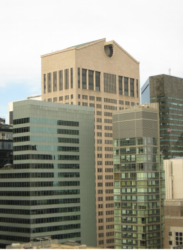
AT&T Building. Image credit: LPC.
Designation will include that owners intend to demolish, but report will focus on the significance of the main tower. On July 31, 2018, Landmarks voted to designate the former AT&T Headquarters Building, at 550 Madison Avenue, an individual City landmark. The 37-story-tall, granite-clad tower was designed by Philip Johnson and John Burgee, and completed in 1983. An early major work of postmodern architecture, the tower rejected the unadorned glass curtain walls of the International Style, and reintroduced masonry cladding and ornament, in a playful pastiche of quotation. The pinkish Stony Creek granite recalled the City’s Beaux Arts architecture, while at the base a monumental central entrance arch is flanked by Renaissance-inspired flat arches that originally opened to twin arcade beneath the tower. The iconic pediment topping the building, with its circular opening, recalls sources such as Chippendale furniture and a 15th-century Florentine chapel.
The building captured the public’s imagination and garnered significant amount of media attention. Johnson appeared on the cover of Time Magazine holding a model of the building. He was awarded a Pritzker prize in 1979.
The arcades were converted to shops and the open pedestrian space was enclosed in the early 1990s.
The tower was commissioned to serve as AT&T’s corporate headquarters, but the company never fully occupied the building after divesting many of its division following a Federal antitrust lawsuit. AT&T leased the property to the Sony Corporation in 1991, and Sony acquired the building 2002. Sony sold the building to the Chetrit Group, who intended to convert the tower to residential use. Chetrit’s plan was not realized, and Saudi-based investment firm the Olayan Group acquired the property in 2016. The building is currently vacant.
At June 19, 2018, hearing, representatives of RXR realty, who are redeveloping the property in partnership with Olayan as contemporary office space endorsed designation. Representatives said the owners intended to remove a rear annex, to create publicly accessible green space.
Council Member Keith Powers testified in support of designation, while urging the Commission to allow the owners to create public space where the annex now stands. A representative of Community Board 5 recommended designation, and asked Landmarks to look at potential interior landmarks in the building.
The designation was supported by preservationist organizations, as well as by the Real Estate Board of New York, the New York Building Congress, and the Association for a Better New York, who requested that Landmarks give the owners latitude in bringing the tower back to active use.
At the July meeting on designation, the Research Department’s Matt Postal recommended designation of the entire property, but stated that design intent of the structure was focused on the prominent skyline tower, while the simply designed annex, built to house retail kiosks, was secondary. Postal said the designation report, when published, would identify the tower as having “primary significance.”
Acting Chair Fred Bland remembered reading about the proposed tower as a young architect and distinctly thinking “Modernism is now dead.” While postmodern architecture did not prove enduring, the AT&T Building’s quality craftsmanship and “integrity of design” elevated above the buildings that followed in its wake.
Commissioner Kim Vauss believed the building has stood the test of time, recalled that the construction commenced when New York was at an economic nadir, and it proved that the era of architectural statements was not over, and the City was not dying. Commissioner Adi Shamir-Baron reflected on the building’s mixed legacy, and its curious relationship to the work of the Commission. She said Johnson’s design, as a “rhetorical device,” turned common perceptions of authenticity on their head, by playing with formal and stylistic languages, and quoting historicist styles, revealing that that American architectural style like Greek Revival, were also rhetorical. She also found part of the building’s mixed legacy to be that of the “star architect” making prominent self-referential statements.
Commissioner Michael Goldblum said, regardless of matter of taste, designation of the tower would represent the significance of postmodernist architecture and its effect on the nation and world. Goldblum said the tower merited protection as “a pivotal building in a pivotal style,” and said the Commission should remember Frank Furness, an architect whose major works were destroyed during a period when his style was out-of-favor, and later revered as influential and significant.
Goldblum further asked that the designation report reflect the architects’ original intentions for the arcade and pedestrian walkway at the base.
Commissioners voted unanimously to designate the building an individual City landmark.
LPC: 550 Madison Avenue (Former AT&T Headquarters Building), 550 Madison Avenue, Manhattan (LP-2600) (July 31, 2018).
By: Jesse Denno (Jesse is a full time staff writer for the Center for NYC Law.)

